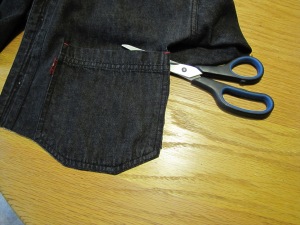Here’s an article that Gail Lee Martin wrote for the eHow site back in 2008.
“This easy craft using worn-out blue jeans will appeal to teens. I taught my granddaughter to make them for gifts for her friends in high school. The jean pockets with a magnet on the back make a handy storage pocket for a school locker. They stick right to a metal locker to hold pens or a notepad at a handy level.

Pocket full of daisies clipboard by deemac1
The locker pockets make fun gifts or can be used at home or in a work locker as well. Here’s how to make this easy craft.
I cut the hip pockets from my collection of blue jeans. I’d been saving them to make my son a blue jean quilt. We cut clear through the jeans to make an enclosed pocket with a front and a back. (photo by Gail Lee Martin)
You can get old jeans at yard sales or the Goodwill Store. Don’t worry if the knees are ripped, there are stains on them or the hems are frayed. All you need are the pockets. Check that the pockets are in good shape.
You can save the rest of the blue jeans to make pot holders, patchwork quilts, or even rag rugs.

Cut around the jean pocket (photo by Virginia Allain)
We glued magnetic strips to the back part of the cut-out jeans pocket so they would stick to the inside door of school lockers.
You can use old advertising magnets to glue onto the back of the pockets. It takes several to hold the pocket onto the metal. Magnets are also available in sheets from Amazon. Just cut them to the size you want.
Choose Some Embellishments to glue onto the jean locker pockets
Rummage around the house to see what decorative bits and pieces you have on hand. We decorated them to fit the person she was going to give them to.
Pink bows and buttons were hot glued to the front for one girl. Seashells or small rocks to some for the boys. Paper clips, erasers and pencils were added to another one. Many jeans have logos on their pockets that make them special to start with.
Add Rhinestones to the Blue Jean Locker Pocket if you want some bling
If you’re making these with your children or grandchildren, turn them loose with a variety of “jewels” or sequins so they can decorate their locker pocket to suit their personality.
Fabric Paints Look Great for Decorating the School Locker Pockets
Well, these just make this craft project even more fun for you! And your kids or grandkids will really get into decorating their locker pocket with these fabric paints.
What to Put in a Locker Pocket made of blue jean pockets
Small pads of paper, pens, rulers, whiteout and pencils were placed inside the pockets. They could even keep their house keys in the locker pockets.Other ideas would be a small pocket mirror and a comb.
Make Blue Jean Pockets for Mom or Dad
These would make cute gifts for a child to give their mother for the refrigerator door or sewing machine. Decorate them to suit the person and place. They would be great also for fathers to put in their workshop and garden shed.

Short version of the instructions (screenshot from Gail’s original article)












